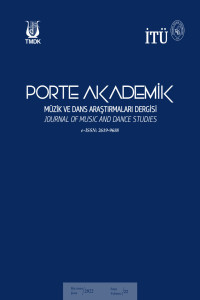A Technical Review of White Noise in A Spotify Sample
A Technical Review of White Noise in A Spotify Sample
As of its development, synthesizers used in the early stages of electronic music had noise panels, to present a realistic imitation of several instruments like woodwinds, brass bells, strings and some percussion instruments. These noise panels played the most important role for sound designers and music producers in developing their usage practices of white noise. In time, after the effects of white noise on humans began to be examined with scientific studies, it became possible to use white noise for alternative purposes other than its primary purpose in the production universe. Some opinions are that white noise is an auditory element observed in nature and it played an important role in the auditory side of human evolution. In this respect, white noise evokes the idea of "organic" in the field of mixing, in signal generation or processing stages of electronic music production to producers. In the process of invention and development of synthesizers and also in the present, attaching or integrating white noise into synthesis has been one of the various basic methods integrated in synth music to achieve an "organic" sound. Also, white noise or other noise signals are frequently used in foley creation processes of motion pictures to create the perception of "field sound". With all these aspects, white noise is a unique subject for all auditory disciplines and it is suitable for examination. Today, music production has become quite individual as a result of the software developments which have created virtual studios. Consequently, white noise was also affected by this individualization, subjected to different perspectives and became an easily produced and marketed product. The development of digital audio workstations has a great impact on this evolution. Ultimately, as digital sound processing stations began to become widespread in personal computers, approaches to white noise have diversified and today, white noise has been shaped by different digital sound processing methods (DSP). So that it became sort of a functional relaxation tool. In this study, technical practices that enable white noise to become a final product in online music markets will be examined and the role of white noise in consumption practices will be discussed. Also, the connection between the changes caused by the technical practices used in the production phase and the form of the white noise in consumption will be made visible in this way.
Keywords:
Music, White Noise, Sound Design Spotify,
___
- Anderson, Joseph. 2009. “Classic Stereo Imaging Transforms-a review.” Espacio y Música: Ciencia, Tecnología y Estética. pp. 1-15. Buenos Aires: Quilmes University Press.
- Capritto, Amanda. 9 July 2019. “The Secret to Better Sleep: Pink, Blue and Brown Noise”. https://www.cnet.com/health/white-noise-pink-noise-blue-noise-brown-noise/ (6 January 2021).
- Carl Q. Howard, Aaron J. Maddern, Elefterios P. Privopoulos. 2011. “Acoustic Characteristics for Effective Ambulance Sirens.” Acoustics Australia. pp. 44.
- Ebert, Joel. 22 May 2019. “White Noise Machines Installed in Glen Cassada's Office; Ex-aide eavestdropped on Meeting Rooms.” The Tennessean. https://www.tennessean.com/story/news/politics/2019/05/22/glen-casada-news-house-speaker-office-renovations-white-noise-machines-cost-taxpayers/3766658002/ (04 March 2021)
- Erteber, Ergin. 2021 interviewer Bahadırhan Koçer. "Beyaz Gürültü" Üzerine.
- Goldsmith, Kevin. 02 July 2020. “How Often Do Spotify Playlists Update”. https://www.quora.com/How-often-do-Spotifys-playlists-update (03 January 2021).
- Goran B.W. Soderlund, Sverker Sikström, Jan M. Loftesnes, Enmund J.S. Sonuga-Barke. September 2010. “The Effects Of Background White Noise On Memory Performance in Inattentive School Children” Behavioral and Brain Functions. pp. 1-4.
- Hagood, Mack. 2019. Hush, Media and Sonic Self-Control. London: Duke University Press.
- Hill, Kashmir. 14 February 2020. “Activate This 'Bracelet of Silence' and Alexa Can't Eavesdrop.” The New York Times. https://www.nytimes.com/2020/02/14/technology/alexa-jamming-bracelet-privacy-armor.html (02 March 2021)
- Inglis, Sam. January 2004. “Sound Toys Filter Freak”. https://www.soundonsound.com/reviews/sound-toys-filter-freak (22 March 2021)
- J. C. Schmidt, Janet C. Rutledge. 1996. “Multichannel Dynamic Range Compression for Music Signals.” Proceedings of the IEEE InternationalConference on Acoustics, Speech, and Signal Processing. pp. 1013-1016. Atlanta.
- J.A.D Spencer, D.J. Moran, A. Lee, D. Talbert. 1990. “White Noise and Sleep Induction.” Archives of Disease in Childhood. pp. 135-137.
- Julia K. MacCallum, Aleksandra E. Olszewski, Yu Zhang, Jack J. Jiang. 2010. “Effects of Low-Pass Filtering on Acoustic Analysis of Voice.” Journal of Voice: Official Journal of the Voice Foundation, pp. 15-20.
- Kalma, Ariel, 2021. interwiever Bahadırhan Koçer. On "White Noise".
- Katz, B. 2007. Mastering Audio: The Art and the Science. Amsterdam: Focal Press.
- Kirsten Nunez, Elaine K. Luo. June 2019 “What is Pink Noise and How Does It Compare With Other Sonic Hues”. https://www.healthline.com/health/pink-noise-sleep#_noHeaderPrefixedContent (6 January 2021).
- Mancini Carter, Ron Bruce. 2009. “Op Amps for Everyone.” Texas Instruments, pp. 10-11.
- Naomi B. H. Croghan, Kathryn H. Arehart, James M. Kates. 2012. “Quality and loudness judgments for music subjected to compression limiting.” The Journal of the Acoustical Society of America, pp. 1177-88.
- Önen, Ufuk. 26 March 2018. “Mikste Panorama ile İlgili Bir Kaç Not, 2”. https://www.ufukonen.com/tr/mikste-stereo-panorama-ile-ilgili-birkac-not-2-bolum.html (6 January 2021).
- Reiss, Joshua. 2010. “Design of Audio Parametric Equalizer Filters Directly in the Digital Domain.” IEEE Transactions on Audio Speech and Language Processing, pp. 1843-1848.
- Singhal, Anirudh. 2014. “Filter Design: Analysis and Review.” Anirudh Singh Int. Journal of Engineering Research and Applications, pp. 236.
- Windsor, L. 2000. “Through and Around the Acousmatic: The Interpretation of Electroacoustic Sounds.” Music, Electronic Media and Culture, pp. 7-35.
- Başlangıç: 2010
- Yayıncı: İstanbul Teknik Üniversitesi
Sayıdaki Diğer Makaleler
A Technical Review of White Noise in A Spotify Sample
Performativity in Game: The Case of “Yüzen Oda” in Ankara Jam Sessions
Rauf Yekta Bey’in Çocukluk Hatıraları
“Rauf Yekta Bey’in Musiki Antikaları” / Nilgün Doğrusöz (Editör)
